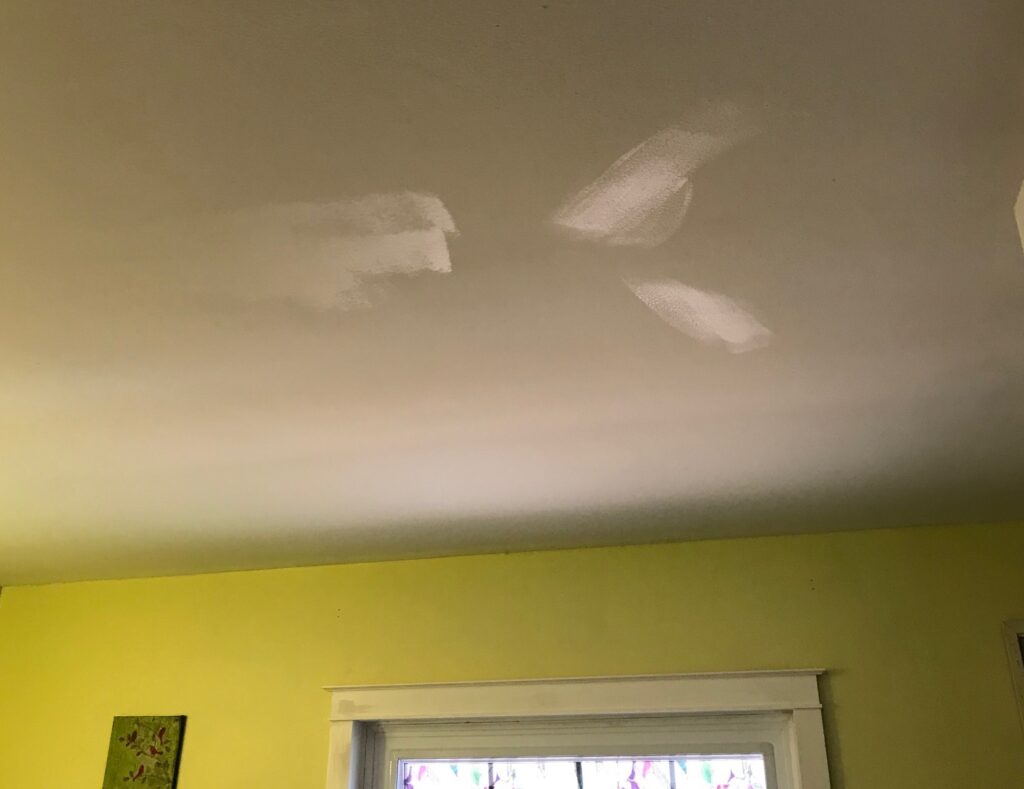Wisdom of old was to keep the dregs of paint from each fresh coat applied to rooms in your house. This allowed touch ups – dabbing a bit here and a line there when accidents dented or chipped the finish, or a bit of decoration was moved. As long as the same paint was used, the result would be invisible.
But not, in my experience in the past few years. From the endless YouTube channels I frequent and adore, flashing is now a thing. Flashing is a newly painted area in a previous finish that shines out, mostly when viewed from the side in bright (sun) light.

At first I thought my ceilings were dirty. That was why I could see the spot touches of flat white ceiling paint on flat white ceiling paint (seen in the photo). Then I did some areas on a wall I’d painted two years previously with the same pale yellow eggshell paint. Seen from the side, the new areas are extra shiny. And, not to be left out, spot touches with semi-gloss on window casings are visible from a distance.
To understand this phenomina, I googled.1 A paint manufacturer2 suggests the reasons for flashing include adverse drying conditions – too damp or too much temperature change or painting over a porous surface (unprimed drywall compound seems the most likely suspect) or the different in thickness of the paint (more or less layers). The recommended solution comes down to priming and repainting, perhaps the entire wall or surface. A briefer summary3 includes that flashing occurs when the paint is applied by different methods e.g. roller vs brush.
Another article4, from a professional painter, adds that areas patched with joint compound may stand out because the surface texture isn’t the same as the rest of the previously painted wall. This I have experienced and makes sense. There would be compounding of the issue if the patched area both absorbed paint differently and was a different texture.
I do find it curious that one solution to avoid flashing is to prime first. Finding paint without primer is difficult anywhere I’ve shopped in recent years. Ironically, putting primer in paint doesn’t avoid the need for primer. Or, is the solution is not so much to prime, as to seal?
Another rabbit hole on Google suggests that there are differences between primers and sealers5. Sealers will prime, and primers seal. The key property of sealers is they make the surface less porous. I’m guessing that the primers in paint are really primers, designed to increase paint adhesion, while flashing may be related to uneven absorption of the paint, requiring a sealer to fix.
Back from primer/sealer segue, an interesting discussion on PaintTalk6 lead me to read between the lines that part of what contributes to flashing now, compared to my memory of decades past, is how fast the paint dries. Paint dries astonishingly quickly now compared to a few decades ago. Quick drying makes it harder to blend and even out the coat. Sealing before applying the top coat slows drying, as the paint isn’t soaking into the surface being painted, and therefore better blending of paint lines can be done to avoid flashing.
Ah-ha!💡Putting all this together, I can understand where my old fuddy-duddy attitude about paint has come from. Back in the good old days, paint covered in one coat. Patches covered easily, and dings touched up invisibly. This was using slow drying, stinky7 paint on plaster walls. Plaster walls would be less porous than paper-coated drywall, and have an inherently rougher surface than drywall. The plaster walls I’ve worked with have been centuries old, with many coats of paint. The difference between 28 and 29 coats of paint is far less than the difference between 3 and 4 coats of paint. If flashing results from an uneven number of coat on the wall, old is less succeptible than new.
What I’ve learned: the good old days of slow drying paint on plaster walls are gone. For drywall: seal (not prime) patches before painting and texture match. Be prepared to paint the whole wall. And maybe my ceiling was dirty. It wouldn’t hurt to wash first before touching up.
1 . This may be a different story, but there was a lot of the same wording in explanation of why and how to fix flashing in the top ten hits, even though the pages were from different sources. These were on the first page of my Google search and use similar passages to describe the causes of paint flashing and/or way to fix it: https://www.sherwin-williams.com/en-us/project-center/maintenance-repair/paint-flashing https://upgradedhome.com/what-is-paint-flashing/ , https://diy.stackexchange.com/questions/254847/how-do-i-fix-paint-flashing , https://www.ehow.com/how_12166529_make-shimmery-paint-walls.html
2 https://www.sherwin-williams.com/en-us/project-center/maintenance-repair/paint-flashing
3 https://www.crowndecoratingcentres.co.uk/advice/uk-troubleshooting/flashing
4 https://upgradedhome.com/what-is-paint-flashing/
5 This is one example: https://www.hdfpainting.com/paint-primer-sealer-undercoat-a-complete-guide-for-beginners/ and while the few articles I read on primers and sealers said much the same thing, they didn’t have word for word similarities like the paint flashing articles.
6 https://www.painttalk.com/threads/how-do-i-prevent-flashing.64249/
7. Paint has been reformulated over the past years to reduce the smell, which may or may not be the same as reducing the VOCs or airborn components, in addition to reducing drying time. All these changes in formulation could be related to flashing, but I didn’t find information on this.